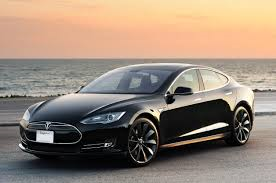Driving Towards the Future
Rod’s recent car purchase has made him a huge fan of Tesla. And it’s got him thinking about a world where electric and driverless cars are the norm.
 My new Tesla Model S is the most amazing vehicle I have ever owned. It achieved a 99 out of 100 score in Consumer Reports’ customer satisfaction survey and now I see why. On my frequent drives over Highway 17 through the redwood forests of the Santa Cruz mountains, the car hangs low and tight to the road and performs outstandingly. It is truly a pleasure to drive.
My new Tesla Model S is the most amazing vehicle I have ever owned. It achieved a 99 out of 100 score in Consumer Reports’ customer satisfaction survey and now I see why. On my frequent drives over Highway 17 through the redwood forests of the Santa Cruz mountains, the car hangs low and tight to the road and performs outstandingly. It is truly a pleasure to drive.
Recently I attended a meeting of an independent association of Tesla owners. The company participates to some degree but this is a genuine community of owners. The Silicon Valley location and the groundbreaking nature of the car mean that the meeting attracts some major talent – engineers, technologists, environmentalists – who bring expertise, innovation, insight and a lot of general brilliance to the discussions. I learned a lot at this incredible meeting of minds.
I had heard predictions that in 30 years, most cars will be electric. I admit I was sceptical – mostly due to the cost – but now I believe it. The attractions of these vehicles from the economic, performance, environmental and efficiency standpoints speak volumes about their ability to usher in a new era of safer, more convenient and more environmentally friendly transportation.
Yet according to Edmunds.com, sales of electric vehicles are flat, even declining slightly. As of August, only 3.6 percent of US sales were hybrids and electric vehicles, vs. 3.7 percent for the same period last year. This could be due to a number of factors, including more efficient gas-driven models coming on the market and recent stable gas prices, which reduce the attraction of owning an electric vehicle. The industry has some way to go to persuade mainstream buyers that electric cars are worth the extra cost.
Though none of them are cheap, electric cars are getting cheaper and more readily available, and that will help grow the market. But better prices come at the cost of lower mileage per battery charge. According to US government figures, Nissan’s Leaf, for instance, gets 84 miles on a single charge while Tesla’s more expensive models can get 200 or more. When you convert the battery charge to a comparable measure of gas consumption, the Tesla produces 88/90 mpg (city/highway). So it’s a lot cleaner and a lot more efficient.
Of course, driving a car hard can drain the battery faster but the Tesla shows you how fast the battery is going down so you can adjust your driving. There is actually a world record of 425.8 miles on one charge set by my friend Bruno Bowden. To achieve that, he maintained a speed of 22 mph – the most efficient speed because of reduced air drag – and used every trick he could think of to reduce friction.
Most people won’t go to those lengths to conserve the charge, but the Tesla Model S is rated at 265 miles on a single charge and that makes it a practical choice in terms of range. It’s now possible to drive the 350 miles from San Francisco to Los Angeles with just a 20-minute recharge at one of the two super-charging stations en route.
Rapid innovation in battery technology suggests that, within 10 years, that 265 miles per charge could increase to 500-600, making the differential between gas and electric much more compelling. In addition, Tesla just announced that it will build a new battery plant in Nevada that should drive that cost down even further – by at least 30 percent according to company estimates – to help it enter the mass market by 2017.
When Tesla began, they feared that the big car companies might use Tesla’s advanced technology to overwhelm them, so they patented everything. But they quickly realised the opposite is true; even now, the big players do not see the full potential of the electric vehicle market. So Tesla has just done the unthinkable: it has made most its electric car patents open source, allowing the public and its competitors to access and use normally proprietary information without permission or payment. Its stated reasons are to advance electric vehicle technology and to accelerate the advent of sustainable transport. And that is a very good thing because a stronger electric vehicle market will ultimately benefit everyone.
Mega changes coming
I believe that three simultaneous trends are fundamentally reshaping automobile travel.
First, as range and viability increase and costs continue to drop, there will be a greater variety of electric vehicles on the road – and more of them. For instance, Tesla is planning to produce a pickup truck to compete with Ford’s popular 150; it should be on the market within five years. As the market expands and demand increases, manufacturers will be motivated to create more and more models to accommodate a wide range of tastes and purposes.
Second, huge demand from developing nations for cheaper electric vehicles will drive greater production and help prices drop faster. A lot of current demand is coming from China, where electric motorcycles will account for 60 percent of total motorcycle demand by 2016, putting 35.3 million of them on the country’s roads. China’s government is understandably worried about ongoing problems of air quality, global warming and inadequate public transport, especially in rural areas, so they are pushing the industry hard to produce efficient electric motorcycles that will not contribute to these problems. There are already over 3000 electric motorcycle manufacturers in China, with over 27,000 different products sold. Other developing nations facing similar problems are also embracing electric vehicles.
The third and perhaps most significant change is the driverless vehicle. Many makers, among them Tesla and Google, are developing versions of the technology and self-driven vehicles will soon be right there next to us as we wait for the light to change. It will likely take a lot of persuasion before they are completely accepted – a degree of cultural adjustment will be needed for people to fully understand their benefits and get past their fears – but once that happens, the world changes forever.
It’s a new world
What are the likely repercussions of these tremendous upheavals in the transport industry?
For a start, less congestion. It’s been suggested that if all cars were computer driven, California’s Interstate 101 – notorious for its massive back ups – would move at speed at rush hour using only two lanes.
Volume will drive down cost. Once driverless cars are well established, they will be more affordable, more available and more convenient, opening the door to vehicles that are readily on call for public use, much as rental bicycles are now available to the public in many city centres. A driverless car could quickly be at your front door whenever it’s needed. That suggests the need for fewer cars – and better air quality as the number of carbon-producing vehicles decreases. As a lifelong environmentalist, I see this as a big benefit.
Having an electric car on call means more and better transport options for people who lack the resources to own their own car or are unable or less able to drive. With a better option available, why own a car? And the ability to summon a car to get to the doctor or supermarket could help otherwise housebound people to live a fuller life.
Other changes may be coming: less business for car companies, fewer jobs for taxi drivers, electric driverless buses, new homes built without garages, fewer fender benders and highway deaths. No one knows for sure but the future portends a massive shake-up in personal transportation through these new technologies.
Summary
I left the Tesla owners meeting understanding that a revolution is coming in transport, energy generation and storage, driven by this new generation of phenomenal electric cars. And it’s exemplified by my wonderful new Tesla.

